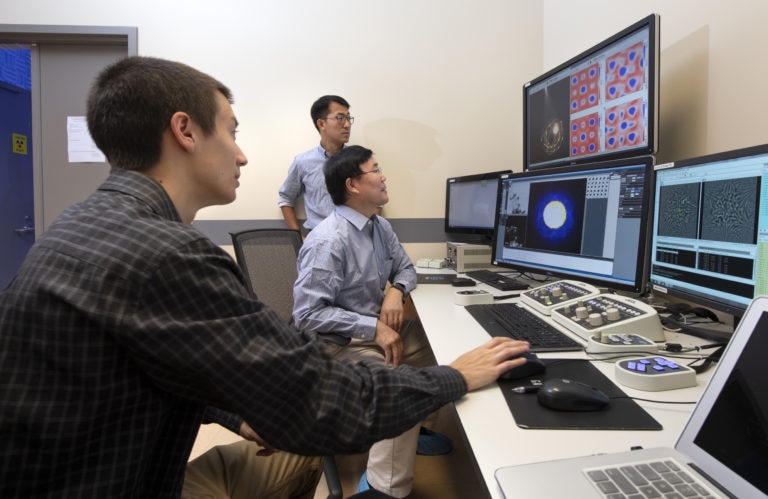Oct 15 2019
A new scanning transmission electron microscopy technique developed by scientists from the University of California, Irvine allows the electric charge density of materials to be visualized at sub-angstrom resolution.
 Christopher Addiego (left), a UCI graduate student in Physics & Astronomy; Xiaoqing Pan (seated in center), UCI’s Henry Samueli Endowed Chair in Engineering and a professor of both Materials Science & Engineering and Physics & Astronomy; and Wenpei Gao (standing), a UCI postdoctoral researcher in Materials Science & Engineering, were able to visualize the electric charge density of materials at sub-angstrom resolution using a new scanning transmission electron microscopy technique. (Image credit: Steve Zylius/UCI)
Christopher Addiego (left), a UCI graduate student in Physics & Astronomy; Xiaoqing Pan (seated in center), UCI’s Henry Samueli Endowed Chair in Engineering and a professor of both Materials Science & Engineering and Physics & Astronomy; and Wenpei Gao (standing), a UCI postdoctoral researcher in Materials Science & Engineering, were able to visualize the electric charge density of materials at sub-angstrom resolution using a new scanning transmission electron microscopy technique. (Image credit: Steve Zylius/UCI)
The UCI researchers used this technique to view electron distribution between molecules and atoms and unravel clues to the roots of ferroelectricity. Ferroelectricity is the potential of specific crystals to exhibit spontaneous electric polarization that can be switched by applying an electric field. The study, which has been described in a research paper published recently in Nature, also demonstrated the charge transfer mechanism between two materials.
“This method is an advancement in electron microscopy—from detecting atoms to imaging electrons—that could help us engineer new materials with desired properties and functionalities for devices used in data storage, energy conversion and quantum computing,” stated team leader Xiaoqing Pan, UCI’s Henry Samueli Endowed Chair in Engineering and a professor of both Materials Science & Engineering and Physics & Astronomy.
His team used a new aberration-corrected scanning transmission electron microscope with a fine electron probe measuring half an angstrom and a fast direct electron detection camera to obtain a 2D raster image of diffraction patterns from an area of interest in the sample. When acquired, the data sets are 4D as they contain 2D diffraction patterns from each probe site in a 2D scanning area.
“With our new microscope, we can routinely form an electron probe as small as 0.6 angstrom, and our high-speed camera with angular resolution can acquire 4D STEM images with 512 x 512 pixels at greater than 300 frames per second,” stated Pan. “Using this technique, we can see the electron charge distribution between atoms in two different perovskite oxides, non-polar strontium titanate, and ferroelectric bismuth ferrite.”
X-ray or electron diffraction methods can be used to measure the electron charge density by assuming an ideally fault-free structure inside the beam-illuminated area. However, according to Pan, determining electron charge density in nanostructured materials including interfaces and flaws is still challenging.
In principle, local electric field and charge density can be determined by electron diffraction imaging using an aberration-corrected scanning transmission electron microscope with a sub-angstrom electron probe.
Xiaoqing Pan, Professor of Materials Science & Engineering and Physics & Astronomy, UCI
Pan added, “While penetrating through a specimen, the electron beam interacts with the internal electric field of material in its pathway, resulting in a change in its momentum reflected in the diffraction pattern. By measuring this change, the electric field in a local region of the specimen can be delineated, and the charge density can be derived.”
Pan explained that even though this principle has been demonstrated through simulations, there has been no successful experiment until now.
The electron charge density maps obtained using the 4D STEM method match with theoretical results from the first-principle calculations. The study of the ferroelectric/insulator interface between bismuth ferrite and strontium titanate using this technique directly shows how features of the bismuth compound’s polar atomic structure leak across the interface, appearing in the normally non-polar strontium titanate.
Wenpei Gao, Study Lead Author and Postdoctoral Researcher, Materials Science & Engineering, UCI
Wenpei Gao continued, “As a result, the interface hosts excess electrons confined to a small region less than 1 nanometer thick.”
According to Pan, this study offers engineers and materials scientists new tools for assessing structures, interfaces, and defects in nanodevices and functional materials. He observed that it might soon be feasible to perform high-throughput mapping of the charge density of materials and molecules, which then can be added to the database of properties helping in the Materials Genome Initiative.
As electron microscopy advances from imaging atoms to probing electrons, it will lead to new understanding and discovery in materials research. The ability to image the charge density distribution around atoms near interfaces, grain boundaries or other planar defects opens new fields for electron microscopy and materials science.
Ruqian Wu, Study Co-Author and Professor, Physics & Astronomy, UCI
Ruqian Wu also led the theoretical work of the study. Pan and his colleagues at UCI were joined by coworkers at Cornell University and Nanjing University, China. The project was funded by the U.S. Department of Energy Office of Basic Energy Sciences’ materials sciences and engineering division, under grant DE-SC0014430.
The experiments carried out in the study used the aberration-corrected scanning transmission electron microscopy facilities in the Irvine Materials Research Institute, of which Pan is the inaugural director. IMRI is a cross-disciplinary institute under UCI’s Office of Research that provides first-class materials characterization facilities to scientists involved in the discovery, development, and commercialization of a wide variety of materials.